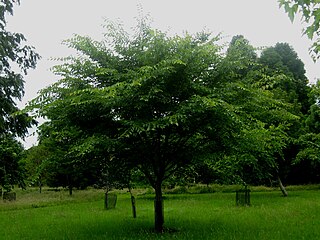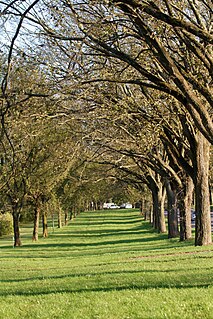
An orchard is an intentional plantation of trees or shrubs that is maintained for food production. Orchards comprise fruit- or nut-producing trees which are generally grown for commercial production. Orchards are also sometimes a feature of large gardens, where they serve an aesthetic as well as a productive purpose. A fruit garden is generally synonymous with an orchard, although it is set on a smaller non-commercial scale and may emphasize berry shrubs in preference to fruit trees. Most temperate-zone orchards are laid out in a regular grid, with a grazed or mown grass or bare soil base that makes maintenance and fruit gathering easy.

A road verge is a strip of grass or plants, and sometimes also trees, located between a roadway (carriageway) and a sidewalk (pavement). Verges are known by dozens of other names, often quite regional; see Terminology, below.

An arborist, tree surgeon, or arboriculturist, is a professional in the practice of arboriculture, which is the cultivation, management, and study of individual trees, shrubs, vines, and other perennial woody plants in dendrology and horticulture.

Wollemia is a genus of coniferous trees in the family Araucariaceae. It was known only through fossil records until 1994, when the Australian species Wollemia nobilis was discovered in a temperate rainforest wilderness area of the Wollemi National Park in New South Wales. It was growing in a remote series of narrow, steep-sided, sandstone gorges 150 km (93 mi) north-west of Sydney. The genus is named after the National Park.

Pruning is a horticultural, arboricultural and silvicultural practice involving the selective removal of certain parts of a plant, such as branches, buds, or roots.

Girdling, also called ring-barking, is the complete removal of the bark from around the entire circumference of either a branch or trunk of a woody plant. Girdling results in the death of the area above the girdle over time. A branch completely girdled will fail and when the main trunk of a tree is girdled, the entire tree will die, if it cannot regrow from above to bridge the wound. Human practices of girdling include forestry, horticulture, and vandalism. Foresters use the practice of girdling to thin forests. Animals such as rodents will girdle trees by feeding on outer bark, often during winter under snow. Girdling can also be caused by herbivorous mammals feeding on plant bark and by birds and insects, both of which can effectively girdle a tree by boring rows of adjacent holes.

Ilex aquifolium, the holly, common holly, English holly, European holly, or occasionally Christmas holly, is a species of flowering plant in the family Aquifoliaceae, native to western and southern Europe, northwest Africa, and southwest Asia. It is regarded as the type species of the genus Ilex, which by association is also called "holly". It is an evergreen tree or shrub found, for example, in shady areas of forests of oak and in beech hedges. In the British Isles it is one of very few native evergreen trees. It has a great capacity to adapt to different conditions and is a pioneer species that repopulates the margins of forests or clearcuts.

Tree shaping uses living trees and other woody plants as the medium to create structures and art. There are a few different methods used by the various artists to shape their trees, which share a common heritage with other artistic horticultural and agricultural practices, such as pleaching, bonsai, espalier, and topiary, and employing some similar techniques. Most artists use grafting to deliberately induce the inosculation of living trunks, branches, and roots, into artistic designs or functional structures.

Ulmus davidiana, also known as the David elm, or Father David elm, is a small deciduous tree widely distributed across China, Mongolia, Korea, Siberia, and Japan, where it is found in wetlands along streams at elevations of 2000–2300 m (6,500–7,500 ft). The tree was first described in 1873 from the hills north of Beijing, China.

The American Elm cultivar Ulmus americana 'Princeton' was originally selected in 1922 by New Jersey nurseryman William Flemer of Princeton Nurseries for its aesthetic merit. 'Princeton' was later found to have a moderate resistance to Dutch elm disease (DED).

Botanic Gardens Conservation International (BGCI) is a plant conservation charity based in Kew, London, England. It is a membership organisation, working with 800 botanic gardens in 118 countries, whose combined work forms the world's largest plant conservation network.
Happy Valley is a garden created by Edwin Harrold in Stenness, Orkney, Scotland.

Pleaching or plashing is a technique of interweaving living and dead branches through a hedge creating a fence, hedge or lattices. Trees are planted in lines, and the branches are woven together to strengthen and fill any weak spots until the hedge thickens. Branches in close contact may grow together, due to a natural phenomenon called inosculation, a natural graft. Pleach also means weaving of thin, whippy stems of trees to form a basketry effect.

A defensible space, in the context of fire control, is a natural and/or landscaped area around a structure that has been maintained and designed to reduce fire danger. The practice is sometimes called firescaping. "Defensible space" is also used in the context of wildfires, especially in the wildland-urban interface (WUI). This defensible space reduces the risk that fire will spread from one area to another, or to a structure, and provides firefighters access and a safer area from which to defend a threatened area. Firefighters sometimes do not attempt to protect structures without adequate defensible space, as it is less safe and less likely to succeed.

The 'Glenn' mango is a mango cultivar that originated in South Florida.

The 'Cogshall' mango is a named mango cultivar that originated in southwest Florida.

The J. C. Jacobsen Garden, also known as the Academy Garden, is a public garden in the Carlsberg area of Copenhagen, Denmark. The main entrance is through a pergola on the left-hand side of the Tap E building, a former bottling plant which now serves as a cultural venue.















